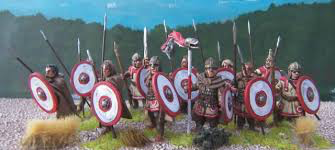Lanciarii Iuniores
Next unit off the desk this week Lanciarii Iuniores, I used a mix of armoured and unarmoured Musketeer and Crusader miniatures in this unit. All hand painted shuiled with a GB draco, which i intend swapping with a Vexillum soon, I have armed them with a Lancea and two 'subarmales'-light lancea. Speidel suggests that they may of had up to five lanceae each.
A few interesting arguments continue about the actual role of the lanciarii. Brian Campbell believes that lanciarii were associated with the 'sacer comitatus' ("sacred retinue") and was part of the small mobile field force accompanying the emperors, he also argues that the lanciarius ranked above a legionary, but below a guardsmen.
Phil barker suspects that the are light armed troops that performed the skirmishing of a Legio and later in the period were formed into their own troop type.
Speidel argues that there were two types of legionary in a legion and uses
Arrian description of two types of longchopohoroi - fully half of the regular legionaries, who throw their weapons overhead of the other half. Arrian's legions in Cappadocia (XII Fulminata and XV Apollinaris) deployed in 10 rank deep formation, ranks five to eight were armed with lancea, nice was archers and ten was horse archers to counter the Alan Cataphracts.
Duncan Head suggests imperial Roman lanciarii had their origins in the republican Antesignani.Duncan also notes that a similar split among the legionaries can be found in a
papyrus detailing donative records of Legio II Traiana in Egypt ca. 300 AD, from which it appears something like 45% of the men mentioned are lanciarii.
Sources
There is a detailed chapter on the lanciarii of Legio II Parthica in Ross Cowan's PhD thesis. It is freely available here
cheers
Matt

























